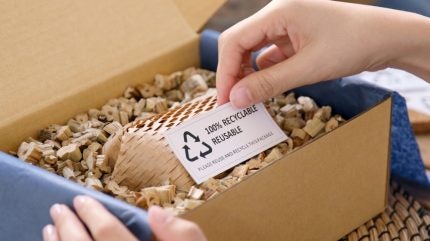
The global packaging industry, worth over $1 trillion, is grappling with a growing crisis: single-use waste. From food delivery containers to e-commerce shipping materials, the world’s dependence on disposable packaging has serious environmental consequences.
In response, reusable packaging has emerged as a compelling alternative, promising a circular model where containers and materials are returned, cleaned, and reused multiple times.

Discover B2B Marketing That Performs
Combine business intelligence and editorial excellence to reach engaged professionals across 36 leading media platforms.
But as this concept gains popularity, a crucial question lingers—can reusable packaging truly scale to meet the demands of modern commerce?
The economics of reuse
At first glance, reusable packaging seems like a no-brainer. If a container can be reused dozens or even hundreds of times, its cost and environmental footprint per use should be significantly lower than its single-use counterpart. However, the transition is not quite so simple.
To begin with, the upfront cost of reusable packaging is considerably higher. While a single-use plastic container might cost a few pence, a durable alternative made from stainless steel, silicone, or rigid plastic could cost several pounds.
For businesses operating at scale, this shift demands considerable capital investment.

US Tariffs are shifting - will you react or anticipate?
Don’t let policy changes catch you off guard. Stay proactive with real-time data and expert analysis.
By GlobalDataThe economics only begin to make sense when the system includes effective collection, cleaning, and redistribution infrastructure—logistics that are often overlooked in the early stages of implementation.
Deposit-return schemes, where consumers pay a refundable fee for packaging, have been effective in some contexts. Germany’s “Pfand” system for beverage bottles, in place since the 1990s, boasts return rates of over 90%.
In such schemes, consumers are incentivised to return containers, ensuring the reuse loop is maintained. Yet replicating this success in other sectors—like online retail or takeaway food—requires more than policy.
It requires behavioural change, supply chain redesign, and technological innovation.
Companies like Loop and Algramo are experimenting with models that integrate reusable packaging into mainstream consumer routines. Loop partners with major brands and retailers to offer products in reusable containers, which are collected, sanitised, and refilled.
Algramo, based in Chile, focuses on low-income communities by offering small quantities of consumer goods in refillable containers, delivered via mobile vending systems.
These models are promising, but they remain largely pilot-scale, and scaling them up remains a formidable challenge.
Infrastructure and reverse logistics
Scaling reusable packaging hinges on solving the logistical puzzle of reverse supply chains.
Unlike disposable packaging, which exits the system after a single use, reusable packaging must return to the point of origin—or at least to a central processing hub—for cleaning and redistribution. This requires a radically different infrastructure.
Reverse logistics involves more than just collecting empty containers. There must be systems for sorting, sanitising, and tracking each item. Hygiene standards, particularly for food-grade containers, are stringent.
Any lapse can undermine consumer confidence and damage brand reputation. These systems are labour-intensive and energy-demanding, raising questions about their true environmental benefit if not powered by renewable resources.
Urban density plays a key role in the feasibility of reusable systems. In densely populated cities, where users are concentrated and return logistics are more straightforward, reuse models are more viable.
In contrast, rural or suburban areas introduce higher transport costs and longer return cycles, which dilute the benefits of reuse. This geographical limitation must be addressed if reusable packaging is to achieve broad adoption.
Digital technology could offer part of the solution. Innovations such as QR codes and RFID tags allow packaging to be tracked through its lifecycle. This not only improves operational efficiency but also provides data on usage patterns, losses, and environmental impact.
Start-ups and scale-ups are increasingly integrating these tools to build smarter, more resilient systems.
Changing consumer behaviour
Perhaps the most unpredictable element in the equation is consumer behaviour. The success of any reuse system ultimately rests on the willingness of individuals to return containers rather than discard them. Habits formed over decades of throwaway convenience are difficult to reverse.
That said, there are signs of change. Younger consumers, particularly Gen Z and millennials, are more likely to support sustainability initiatives and adjust their purchasing habits.
Brands that adopt reuse models often benefit from reputational gains, helping them appeal to this demographic.
But convenience remains king. If reusable packaging is to gain mainstream acceptance, it must match or exceed the convenience of disposables. That means offering easy return options—such as home collection, widespread drop-off points, or automated kiosks.
It also means clear communication about the benefits of reuse, so consumers understand the impact of their actions.
Retailers and brands must play an active role in nudging behaviour. Subscription-based models, loyalty programmes, and app-based rewards can incentivise returns and promote habit formation.
Collaboration across industry, government, and civil society will also be critical in normalising reuse as part of everyday life.
A shift worth pursuing
Reusable packaging is not a silver bullet, but it is a key piece of the puzzle in building a more sustainable economy. While challenges to scalability remain, they are not insurmountable.
With the right combination of policy support, technological innovation, and consumer engagement, reuse can move from niche initiative to industry norm.
The transition won’t happen overnight. But as environmental pressures mount and resource efficiency becomes an imperative, the logic of reuse grows ever stronger.
It’s no longer a question of if reusable packaging can scale—but rather how quickly we can make it happen.





